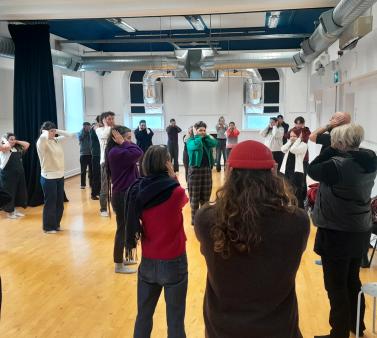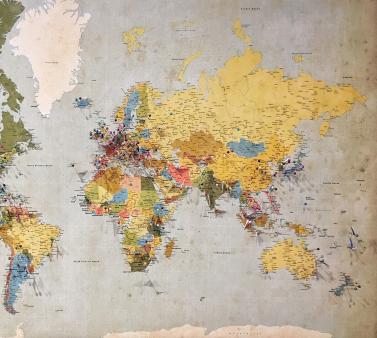
Although clearly impacted by the health crisis, a number of cultural events and activities have nevertheless been able to take place thanks to innovative proposals and solutions from various cultural actors.
Although the campuses remained closed for a large part of the year, artistic initiatives, beautiful gestures, and original proposals flourished in order to maintain a cultural offer accessible to the greatest number. Festivals, exhibitions, conferences, screenings... many events that would not have been possible without the determination of the university community. We invite you to discover the stories and experiences of students who have contributed to bringing culture to life at the university in a difficult context. What adaptations did their cultural activity undergo? How do they assess this past year? How have these practices influenced their daily lives?
Keeping in touch
The challenges of organizing an event in the context of a pandemic are difficult to overcome. However, many organizations have done their best to stay in contact with their public. Some of them have chosen to go completely digital.
Léna Rolland, in charge of communication for the Fac@Fac festival organized by the organization En toute Complicité, looks back on this 21st edition that has been completely transformed: "Basically, Fac@Fac is a 3-day inter-university dance festival that takes place mainly at the Triangle, during the month of March or April. With the health context, it was impossible to consider this format. That's why the team chose to create a new one: Fac@Fac 2.0, a 100% digital festival."
Spread out over two months, the festival offered workshops, conferences, roundtables and online training, always with the aim of promoting dance and making it accessible to everyone. Bleuenn Tassé and Louise Josso, students and Presidents of the organization, presented us this 2.0 edition in video.

The Ciné-Tambour team also had to quickly rethink its programming by offering online screenings. Marion Drouault, a member of the ciné-club's programming workshops, says: "The meeting was launched online: we managed to find the films that were supposed to be shown in the ciné-club's room, in legal streaming (via YouTube or via the Médiathèque Numérique). Sometimes it was impossible for us to find them, so we looked for similar films [...]."
But it's hard to share emotions collectively through online formats. To keep a concrete link with the audience, student-led "after sessions" were created on the Twitch platform. These exchanges were an original exercise that allowed them to maintain a dialogue around the proposed films and to receive direct feedback from the spectators. For Lucas Prost, a film student: "It was a real pleasure for us to be able to live the Ciné-Tambour and receive feedback from the spectators. For my part, I was able to participate in a discussion with Court-Métrange at C-Lab in partnership with the Ciné-Tambour, it was a great experience."

Constrained by regulations of the context and limits on the number of potential visitors, the courses and organizations planning exhibition projects adopted a hybrid format when the context allowed it.
Thus, despite the closure of the Galerie Art & Essai to the public, the students of the Métiers & Arts de l'Exposition Master's program were able to welcome the university community and cultural professionals to present their annual exhibition. To compensate for the impossibility of receiving real visitors, they created a virtual visit. It allows visitors to appreciate the works of photographer Lynne Cohen, while giving a glimpse behind the scenes of this event. A collection of photographs was also set up (#collectelynnecohen). It invited participants to be inspired by the work of the artist to make their own photograph of a private or public interior devoid of any human presence.

As part of the Open House and Arts Week, the students of the Digital Creation Master's degree also maintained their exhibitions accessible only to a limited public. Necessary for research and creation, these moments allow each student to develop his or her practice in real conditions in one of the vast artistic fields in which digital technology intervenes: generative algorithms, computer-assisted music, virtual reality, image, video, artificial intelligence, augmented reality... Beyond the simple maintenance of the event, the class imagined a new form of exhibition during the Open House, called Creative Harmony.
"We then set up a virtual exhibition in partnership with the Recto VRso festival of the Laval Virtual show. This exhibition took place in the Laval Virtual World, an interactive virtual space in which the master's students were able to exhibit their work and meet the public through avatars. We also set up a recording system, in order to stream in real time in the Laval Virtual World the performances taking place on the PNRV stages. Finally, we set up a website, more accessible, to expose our research." Johan Julien, Master Digital Creation.

For the volunteers of the Galerie Art & Essai, the year was particularly tumultuous, as Elise Léger, head of the communication unit of the Galerie Art & Essai, reveals: "With the change of the artistic director and the team of temporary workers, there were many things to change (graphic guidelines, specifications...)." Because of the university's closure, two exhibitions had to be canceled or postponed. The health measures also disrupted the rest of the programming: "For the first exhibition as well as for the L2 Arts-Plastiques* workshop, we had to set up a system of reservations and registrations by email, in order to control the number of visitors (no more than 20 in the space). Much less spontaneous than usual, but at least we had visitors."
Despite difficult conditions, the gallery team adapted to preserve the link with its public and proposed new ways to share exhibitions and collections: "We instituted #CultureChezNous, between May and June, which gathered the volunteers' favorites from past exhibitions: each week, for 8 weeks, was devoted to a favorite exhibition."
The volunteers are now looking forward to welcoming visitors back to the gallery for the last exhibition of the year, Juste un [mo] curated by the Art & Essai Gallery's student coordinators, Alexandre Fillon and Victoria Quesnel.

Looking Back
Behind all these initiatives to "keep culture afloat" at the university, we can be pleased with the determination of the collective in the face of adversity. If this period was difficult and painful for social and cultural interactions, it also led to positive initiatives.
Like the new theme chosen by Fac@Fac, "the rebound", the team fought to make the art of dance survive in extraordinary conditions. This online edition was an opportunity for the festival to expand its audience and its speakers: "Usually our audience comes exclusively from universities in France, and the artists are exclusively dancers and choreographers from Rennes."
Léna Rolland recalls the complexity and difficulty of organizing an event in such a context, but she also saw perspectives for the year to come:
"We had to review everything, reinvent everything, but it was also a rather pleasant form of challenge. We succeeded in having an audience present at our online events (50 participants for the workshop of the dancer Marie Bugnon). The programming was rich and new, we managed to attract a lot of people from different backgrounds, ages and professions. It is highly possible that even if next year's festival will be in person, we will still propose a digital event in order to continue to open Fac@Fac to new horizons."
This year was an opportunity for the students of the Digital Creation Master's degree to think about a new way to present their work to the public, and thus democratize access to the stages of ongoing research in the little-known field of digital art. They were thus able to experiment with new mediation devices and reach a wider public.
Another positive point emerges from the reorganization of the different structures: an awareness of the importance of culture in our lives, especially in its collective dimension. "I would say that there has been a deepening/increasing love for culture and cinema, because it is when we are deprived of something that we realize how important it is to us, how indispensable. It was obvious to us that we would adapt and share our content in a different way. So this quick ability to react showed us how motivated and passionate we were about what we were doing. That to me is the biggest positive, even if it's invisible."
- Marion Drouault, member of the Ciné-Tambour workshops
But all are unanimous: nothing replaces the true meeting between the actors of culture and its public. If the Ciné-Tambour has managed to capture its audience little by little through testing and experimentation, sharing, exchanging and feeling do not have the same flavor. For Hugo Goby, "These experiences confirm to me that it is essential to maintain dialogues on artistic works, that the common appreciation in the Tambour room is more than a luxury of viewing and that it is determining for the good appreciation of the works that make up the programming."

Cultural commitment, an avenue for personal development
Whether these cultural activities are carried out within the framework of a course or an organization, they cannot simply be reduced to the sphere of leisure. They are an essential part of public cultural policies insofar as they sensitize and educate, providing students with leadership opportunities before they enter a new phase of their lives.
This cultural investment underlines the desire of the students to continue to work together to maintain an artistic offer which has proved to be essential in this period of isolation: "Since the beginning of the Covid period, I have had the opportunity to participate in the organization of 3 exhibitions (2 on campus with the master's program and one at 4Bis with my association Contrast), as well as several creative workshops. These moments were very important for me and kept me motivated. My participation in the cultural activities associated with the program allowed me to get out and about, to keep the link with my fellow students and in a stimulating way.
- Johan Julien, student in master 2 Digital Creation
"I have other projects (unrelated to culture) for my professional future, so it was more the preparation for these projects that helped me to get through this period, but knowing that our very last exhibition of the academic year, Just a [mo], was going to take place and be open to the public, it was quite pleasing and quite encouraging for the future."
- Elise Léger, communications manager Art & Essai Gallery
"The Tambour workshop was crucial in maintaining a social and creative link through videoconferences where we spent a few hours discussing possible programming for the fall."
- Hugo Goby, member of the Ciné-Tambour workshop



